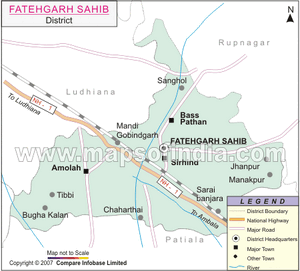Khamanon

Khamanon is city and tahsil in district Fatehgarh Sahib of Punjab in India.
Villages in Khamanon tahsil
Ajner, Amargarh, Amrala, Badla, Bara Badechh (Kalan), Barwali Kalan, Barwali Khurd, Bathan Kalan, Bathan Khurd, Baur, Bhambri, Bhamian, Bhari, Bhattian, Bhuttan, Bilaspur, Burj, Chandiala, Chari, Chhota Badechh (Khurd), Dhanaula, Dhianu Majra, Dholewal, Dulwan, Faraur, Gaggarwal, Hargana, Hawara(kalan), Jatana Niwan, Jatana Uncha, Kale Majra, Kalewal, Kalewal, Khamanon (NP), Khant, Kheri Naudh Singh, Kotla Ajner, Kotla Badla, Kotla Masud, Lakhanpur, Lohar Majra Khurd, Maheshpura, Majri, Manderan, Manela, Maneli, Manpur, Mansoorpur, Mirpur, Mohan Majra, Mutton, Nanglan, Nanowal, Panechan, Panj Koha, Pohlo Majra, Prempur, Raipur, Raipur Raian, Ramgarh, Ranwan, Rattangarh, Raya, Saidpura, Sandhari Majra, Sanghol, Shadipur, Shamshpur Singha, Sidhupur Kalan, Sidhupur Khurd, Sohavi, Thikriwala, Todarpur,
Jat Gotra
History
The Khumanun estate
Lepel H. Griffin writes: [1] The second case referred to the estate of Khumanun, consisting of 58 villages, and situated a few miles north of Sirhind. Pattiala had in it no proprietary rights, but,
- * Commissioner Cis-Satlej States to Government Punjab, No. 184 dated I6th August 1865. Government Punjab to Government of India No. 630, dated 29th August. Government of India, to Government Punjab, No. 643, dated 10th October 1855.
- Commissioner Cis-Satlej States to Government Punjab, No. 106, dated 4th May 1857. Government Punjab to Commissioner, No. 400, dated 25th April, and to Government of India, No. 624, dated 4th September 1857. Government of India, No. 4641, dated 19th November 1857.
in 1815, it was entrusted to her by Sir D. Ochterlony, for administrative purposes ; and the, Pattiala Chief was empowered to exercise criminal jurisdiction and exact service. When the English first took the Cis-Satlej territory under their protection, they seem to have fancied that the whole was under the jurisdiction of a few great Chiefs, and it was only gradually that it was discovered how numerous were the small communities claiming virtual independence. The Government at length sought to lighten it own labors by making the principal Chiefs responsible for the conduct of their weaker neighbours, authorizing them to hear and decide their disputes, and this course, though it gave a power to some States which was not unfrequently abused, on the whole worked well.
Transferred to Pattiala jurisdiction in 1815:
In 1815, the Sikhs of Khumanun, a large co-parcenary body, were so transferred to Pattiala jurisdiction. The next year Sikhs of Panjokra, Syadpur, Dhanori, Lakhnour, Khumbra and Barail; and, in 1821, the Chaharumis, co-sharers with Pattiala, were referred to her for general control and, in 1823, the Sikhs of Tullakour. *
Colonel Mackeson, in his report of 1847, suggested that the Khumanun Sikhs might be permitted to select whether they would remain under Pattiala or come under British jurisdiction ; but the Government of India, while admitting that it would be desirable to assume the direct control of the estate, declared that it was not desired to alter the position or
- * Of these, the Khumanun, Tullakour, Dhanori and Lakhnour Sikhs are still under Pattiala jurisdiction for life of the Maharaja, paying commutation tax in lieu of service to Government.
limit the authority of the Pattiala Chief, as exercised before, the Satlej campaign, but rather to improve and increase them, in consideration of the excellent service then rendered by him, and declined to alter the arrangement which would be reconsidered at the death of the Maharaja.
Population
Notable persons
Gallery
-
Sirdar Ajmer Singh Kang of Khamano Kalan, Misl:- Dallewalia, Estate- Khamano Kalan, Dynasty:- Kang, Source - Jat Kshatriya Culture
External links
References
Back to Punjab


